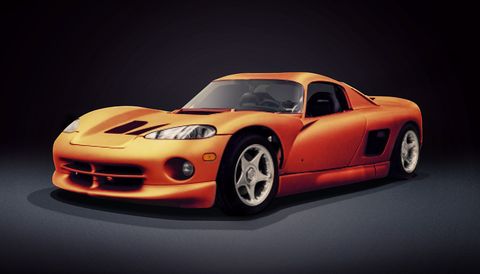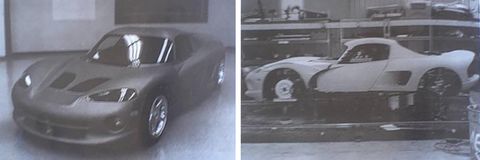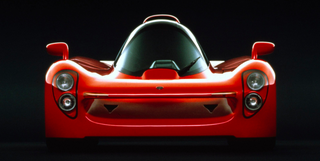You are using an out of date browser. It may not display this or other websites correctly.
You should upgrade or use an alternative browser.
You should upgrade or use an alternative browser.
Why Dodge Investigated, Then Abandoned, A Mid-Engine Viper
- Thread starter Maniacmechanic1
- Start date
Maniacmechanic1
solid fixture here in the forum
Why Dodge Investigated, Then Abandoned, A Mid-Engine Viper
In the mid-90s, a secret team of Dodge engineers studied what it would take to build a mid-engine Viper.

By Bob Sorokanich
Dec 28, 2018

Road & Track
Throughout its 25 years and five generations, the Dodge Viper stayed true to its traditional recipe: a naturally-aspirated V10, a manual transmission, and a front-engine, rear-drive layout. The old-school vibe was part of the allure—as other performance cars grew softer and more civil, the Viper stayed raw. It was brash and American, and fans loved it for that.
So imagine my surprise when, over at Hagerty, Thom Taylor published an article explaining that, in the mid-1990s, Dodge embarked on a side project to investigate the possibility of building a mid-engine Viper.
It's a familiar story to die-hard Viper fans and the folks who worked at Dodge at the time. But outside those circles, it's a barely-known bit of Viper lore. As Taylor points out, the stillborn mid-engine Viper has a surprising relationship to another mid-engine American performance car, the Ford GT. You should absolutely read his piece explaining that connection.
I wondered at something a little different: Why didn't Dodge pursue the mid-engine Viper further? It's an especially relevant question when you consider the state of the American performance car today. Ford has built two generations of mid-engine supercars in the 21st century; the long-anticipated mid-engine Corvette is imminent. If a few things had gone differently, could Dodge have beaten them both to the punch?
Shown above, a Road & Track rendering of what a mid-engine Viper could have looked like, based on a photograph of a prototype built by Dodge in the mid-90s.
It's easy to see how the idea of a mid-engine Viper got started. Just look at the team that brought the Viper into production. Lee Iacocca was chairman of Chrysler; Bob Lutz was president. Tom Gale, the man who penned the Prowler as well as Chrysler's revolutionary cab-forward cars, was head of design. Chris Theodore, who later spearheaded the 2005 Ford GT, was a general manager. Francois Castaing, a vice president, had been a race car engineer in France before joining AMC and then Chrysler. Roy Sjoberg, formerly involved in Zora Arkus-Duntov's experimental mid-engine Corvettes, was chief engineer.
Car guys, all of them, as were the dozens of folks they recruited for the Viper team. So it's not surprising that, somewhere around 1996, some of them began toying with the idea of a mid-engine Viper.
The mid-engine project was actually proposed twice. The first time was around the debut of the second-generation Viper—the update that brought roll-down windows to the roadster and introduced the GTS coupe. The second time was a little later, roughly 1998, when work was about to begin on the third generation of the sports car.
The proposal got far enough along that the team built a full-scale mockup, along with some interior models. They studied packaging and layouts of the major components—engine, gearbox, dashboard, driver and passenger seats—and took a preliminary crack at styling.

Courtesy ViperClub.org
So what prevented the idea from going any further? "One word: investment," Roy Sjoberg told me. "You always get in a problem, be it with a Ford GT or a Corvette or a Viper, you’re fighting the mainstream [vehicle programs] for investment dollars. And the mainstream doesn’t like it, they think they’d make more money by doing a better minivan or Camaro or Mustang."
Advertisement - Continue Reading Below
In particular, numerous people I spoke with pointed to one potential expense that killed the mid-engine Viper: The gearbox. Two drivetrain layouts were proposed. One would require an all-new transaxle to mount behind the engine, something one source told me could cost tens of millions of dollars to produce. Another setup, similar to Lamborghini drivetrains of the day, would use the standard Viper's drivetrain, rotated 180 degrees so the transmission faced forward, then send power to the rear axle via a jackshaft. Neither was investigated much further than a few mock-ups.
But there was another reason why some folks on the Viper team were averse to the mid-engine idea: tradition.
"I was dead set against this whole thing," Herb Helbig told me. "I’m an American hot rod guy and I thought this was not the right thing to do with our icon. And I was very vocal about it."
Helbig was Senior Manager of Vehicle Synthesis on the Viper from the model's debut until his retirement from Chrysler in 2008. He's remained deeply involved in the enthusiast community—the "Viper Nation"—and his work to keep the Viper raw and bare-bones throughout his career has earned him a nickname: Grailkeeper.
"My side of the fence was, this is absolutely contrary to Viper," Helbig said, explaining his stance on the mid-engine proposal at the time. "If you want to build a mid-engine sports car, fine, don’t call it a Viper. Because Viper is a front-engine rear-drive car. It’s a Cobra for the '90s. They didn’t build any mid-engine Cobras last time I checked."
And according to Helbig, some Viper fans at the time felt the same way. "Somewhere along the line, word leaked that there might be a mid-engine car in the works. And the Viper Nation, as I remember it, was not very excited about a mid-engine car," Helbig told me. Devotees loved the brashness, the American-ness, of the Viper. A mid-engine variant, Helbig said, felt too European.
So he was relieved when the engineering and financial challenges of the project led Chrysler's top brass to abandon the idea. "I don’t want to say everybody came to their senses, but when they looked at the whole picture, they said, this is probably not the right thing to do," Helbig told me. "I was fortunate because I just sat back and got my way without really having to do a whole lot. The thing kind of killed itself because of the investment. I didn’t have to get up on the table and start jumping around, yelling about messing with my hot rod."
In preparing this article, I spoke with a number of people who were involved in the Viper program throughout the car's history. Some asked not to be quoted, others referred me to colleagues. But every individual I contacted described this small group within Chrysler as a collection of some of the best minds in the business.
Helbig echoed the sentiment. "One of the great things about our team was, I could tell my senior management what I thought, without fear of reprisal, and I wasn’t the only one," he told me. "We had respect and understanding at the highest levels of the company. I could call Bob Lutz and say, this is not right, put me down as the guy who said this is the wrong thing to do for our car."
I asked Helbig if, with a mid-engine Corvette on the way, his opinion of the mid-engine Viper proposal has changed. It would be pretty great, I said, if each of the Big Three had a mid-engine supercar on the market.
"I’m glad that they’re building a mid-engine Corvette," he told me, "because that just continues to separate the Corvette from the Viper. And I don’t regret for a minute that we didn’t build the mid-engine car."
Watch Next
Listen to the Aston Martin Valkyrie's V12
Current Time 4:52
Remaining Time -0:00
More From Vintage

What the E Stood For in 'Maserati Biturbo E'

This Custom Strosek Porsche 911 Is for Sale

Yamaha's Lost Supercar Sounds Incredible
In the mid-90s, a secret team of Dodge engineers studied what it would take to build a mid-engine Viper.

By Bob Sorokanich
Dec 28, 2018

Road & Track
Throughout its 25 years and five generations, the Dodge Viper stayed true to its traditional recipe: a naturally-aspirated V10, a manual transmission, and a front-engine, rear-drive layout. The old-school vibe was part of the allure—as other performance cars grew softer and more civil, the Viper stayed raw. It was brash and American, and fans loved it for that.
So imagine my surprise when, over at Hagerty, Thom Taylor published an article explaining that, in the mid-1990s, Dodge embarked on a side project to investigate the possibility of building a mid-engine Viper.
It's a familiar story to die-hard Viper fans and the folks who worked at Dodge at the time. But outside those circles, it's a barely-known bit of Viper lore. As Taylor points out, the stillborn mid-engine Viper has a surprising relationship to another mid-engine American performance car, the Ford GT. You should absolutely read his piece explaining that connection.
I wondered at something a little different: Why didn't Dodge pursue the mid-engine Viper further? It's an especially relevant question when you consider the state of the American performance car today. Ford has built two generations of mid-engine supercars in the 21st century; the long-anticipated mid-engine Corvette is imminent. If a few things had gone differently, could Dodge have beaten them both to the punch?
Shown above, a Road & Track rendering of what a mid-engine Viper could have looked like, based on a photograph of a prototype built by Dodge in the mid-90s.
It's easy to see how the idea of a mid-engine Viper got started. Just look at the team that brought the Viper into production. Lee Iacocca was chairman of Chrysler; Bob Lutz was president. Tom Gale, the man who penned the Prowler as well as Chrysler's revolutionary cab-forward cars, was head of design. Chris Theodore, who later spearheaded the 2005 Ford GT, was a general manager. Francois Castaing, a vice president, had been a race car engineer in France before joining AMC and then Chrysler. Roy Sjoberg, formerly involved in Zora Arkus-Duntov's experimental mid-engine Corvettes, was chief engineer.
Car guys, all of them, as were the dozens of folks they recruited for the Viper team. So it's not surprising that, somewhere around 1996, some of them began toying with the idea of a mid-engine Viper.
The mid-engine project was actually proposed twice. The first time was around the debut of the second-generation Viper—the update that brought roll-down windows to the roadster and introduced the GTS coupe. The second time was a little later, roughly 1998, when work was about to begin on the third generation of the sports car.
The proposal got far enough along that the team built a full-scale mockup, along with some interior models. They studied packaging and layouts of the major components—engine, gearbox, dashboard, driver and passenger seats—and took a preliminary crack at styling.

Courtesy ViperClub.org
So what prevented the idea from going any further? "One word: investment," Roy Sjoberg told me. "You always get in a problem, be it with a Ford GT or a Corvette or a Viper, you’re fighting the mainstream [vehicle programs] for investment dollars. And the mainstream doesn’t like it, they think they’d make more money by doing a better minivan or Camaro or Mustang."
Advertisement - Continue Reading Below
In particular, numerous people I spoke with pointed to one potential expense that killed the mid-engine Viper: The gearbox. Two drivetrain layouts were proposed. One would require an all-new transaxle to mount behind the engine, something one source told me could cost tens of millions of dollars to produce. Another setup, similar to Lamborghini drivetrains of the day, would use the standard Viper's drivetrain, rotated 180 degrees so the transmission faced forward, then send power to the rear axle via a jackshaft. Neither was investigated much further than a few mock-ups.
But there was another reason why some folks on the Viper team were averse to the mid-engine idea: tradition.
"I was dead set against this whole thing," Herb Helbig told me. "I’m an American hot rod guy and I thought this was not the right thing to do with our icon. And I was very vocal about it."
Helbig was Senior Manager of Vehicle Synthesis on the Viper from the model's debut until his retirement from Chrysler in 2008. He's remained deeply involved in the enthusiast community—the "Viper Nation"—and his work to keep the Viper raw and bare-bones throughout his career has earned him a nickname: Grailkeeper.
"My side of the fence was, this is absolutely contrary to Viper," Helbig said, explaining his stance on the mid-engine proposal at the time. "If you want to build a mid-engine sports car, fine, don’t call it a Viper. Because Viper is a front-engine rear-drive car. It’s a Cobra for the '90s. They didn’t build any mid-engine Cobras last time I checked."
And according to Helbig, some Viper fans at the time felt the same way. "Somewhere along the line, word leaked that there might be a mid-engine car in the works. And the Viper Nation, as I remember it, was not very excited about a mid-engine car," Helbig told me. Devotees loved the brashness, the American-ness, of the Viper. A mid-engine variant, Helbig said, felt too European.
So he was relieved when the engineering and financial challenges of the project led Chrysler's top brass to abandon the idea. "I don’t want to say everybody came to their senses, but when they looked at the whole picture, they said, this is probably not the right thing to do," Helbig told me. "I was fortunate because I just sat back and got my way without really having to do a whole lot. The thing kind of killed itself because of the investment. I didn’t have to get up on the table and start jumping around, yelling about messing with my hot rod."
In preparing this article, I spoke with a number of people who were involved in the Viper program throughout the car's history. Some asked not to be quoted, others referred me to colleagues. But every individual I contacted described this small group within Chrysler as a collection of some of the best minds in the business.
Helbig echoed the sentiment. "One of the great things about our team was, I could tell my senior management what I thought, without fear of reprisal, and I wasn’t the only one," he told me. "We had respect and understanding at the highest levels of the company. I could call Bob Lutz and say, this is not right, put me down as the guy who said this is the wrong thing to do for our car."
I asked Helbig if, with a mid-engine Corvette on the way, his opinion of the mid-engine Viper proposal has changed. It would be pretty great, I said, if each of the Big Three had a mid-engine supercar on the market.
"I’m glad that they’re building a mid-engine Corvette," he told me, "because that just continues to separate the Corvette from the Viper. And I don’t regret for a minute that we didn’t build the mid-engine car."
Watch Next
Listen to the Aston Martin Valkyrie's V12
Current Time 4:52
Remaining Time -0:00
More From Vintage

What the E Stood For in 'Maserati Biturbo E'

This Custom Strosek Porsche 911 Is for Sale

Yamaha's Lost Supercar Sounds Incredible
Maniacmechanic1
solid fixture here in the forum
After reading I have a hard time believing the C8 mid engine Corvette will cost just $60,000.
They have to sell at well over $140k each to even break even.
Between the c8 or no C8 & Mary Barra & Her GM plant closings I think we are watching General Motors slowly dieing.
Pontiac & Oldsmobile are gone.
Pontiac was the Street Racer Division.
Oldsmobile was #1 in Engineering advancements.
They have to sell at well over $140k each to even break even.
Between the c8 or no C8 & Mary Barra & Her GM plant closings I think we are watching General Motors slowly dieing.
Pontiac & Oldsmobile are gone.
Pontiac was the Street Racer Division.
Oldsmobile was #1 in Engineering advancements.
